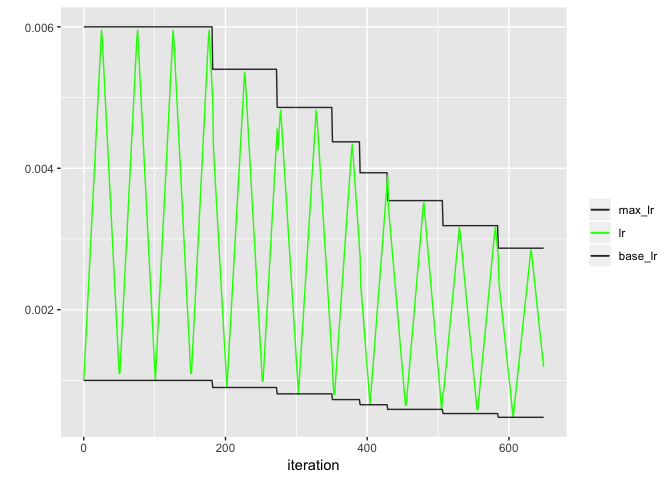The goal of KerasMisc is to provide a collection of tools that enhance the R implementation of Keras. Currently, the package features:
- a Keras callback for cyclical learning rate scheduling as proposed by Smith (2017), closely adapted from the Python implementation and then extended so they the bands are scaled by a constant factor (typically < 1) after the validation loss has not improved for a while. For details, see the README from the Python implementation and the example below for dynamically adjusting bandwidths.
Contributions welcome.
You can install the development version of KerasMisc from GitHub with
remotes::install_github("lorenzwalthert/KerasMisc")Keras callbacks
Let’s create a model
library(keras)
library(KerasMisc)
dataset <- dataset_boston_housing()
c(c(train_data, train_targets), c(test_data, test_targets)) %<-% dataset
mean <- apply(train_data, 2, mean)
std <- apply(train_data, 2, sd)
train_data <- scale(train_data, center = mean, scale = std)
test_data <- scale(test_data, center = mean, scale = std)
model <- keras_model_sequential() %>%
layer_dense(
units = 64, activation = "relu",
input_shape = dim(train_data)[[2]]
) %>%
layer_dense(units = 64, activation = "relu") %>%
layer_dense(units = 1)
model %>% compile(
optimizer = optimizer_rmsprop(lr = 0.001),
loss = "mse",
metrics = c("mae")
)Next, we can fit the model with a learning rate schedule. We dynamically
adjust the bandwidths of the learnin rate (multiplication with 0.9)
whenever the validation loss does not decrease for three epochs. When
decreased, we wait 2 epochs (cooldown) before we set in the patience
counter again.
iter_per_epoch <- nrow(train_data) / 32
callback_clr <- new_callback_cyclical_learning_rate(
step_size = iter_per_epoch * 2,
base_lr = 0.001,
max_lr = 0.006,
mode = "triangular",
patience = 3,
factor = 0.9,
cooldown = 2,
verbose = 0
)
model %>% fit(
train_data, train_targets,
validation_data = list(test_data, test_targets),
epochs = 50, verbose = 0,
callbacks = list(callback_clr)
)We can now have a look at the learning rates:
head(callback_clr$history)
#> lr base_lr max_lr iteration epochs
#> 1 0.001000000 0.001 0.006 0 1
#> 2 0.001198020 0.001 0.006 1 1
#> 3 0.001396040 0.001 0.006 2 1
#> 4 0.001594059 0.001 0.006 3 1
#> 5 0.001792079 0.001 0.006 4 1
#> 6 0.001990099 0.001 0.006 5 1backend <- ifelse(rlang::is_installed("ggplot2"), "ggplot2", "base")
plot_clr_history(callback_clr, granularity = "iteration", backend = backend)
